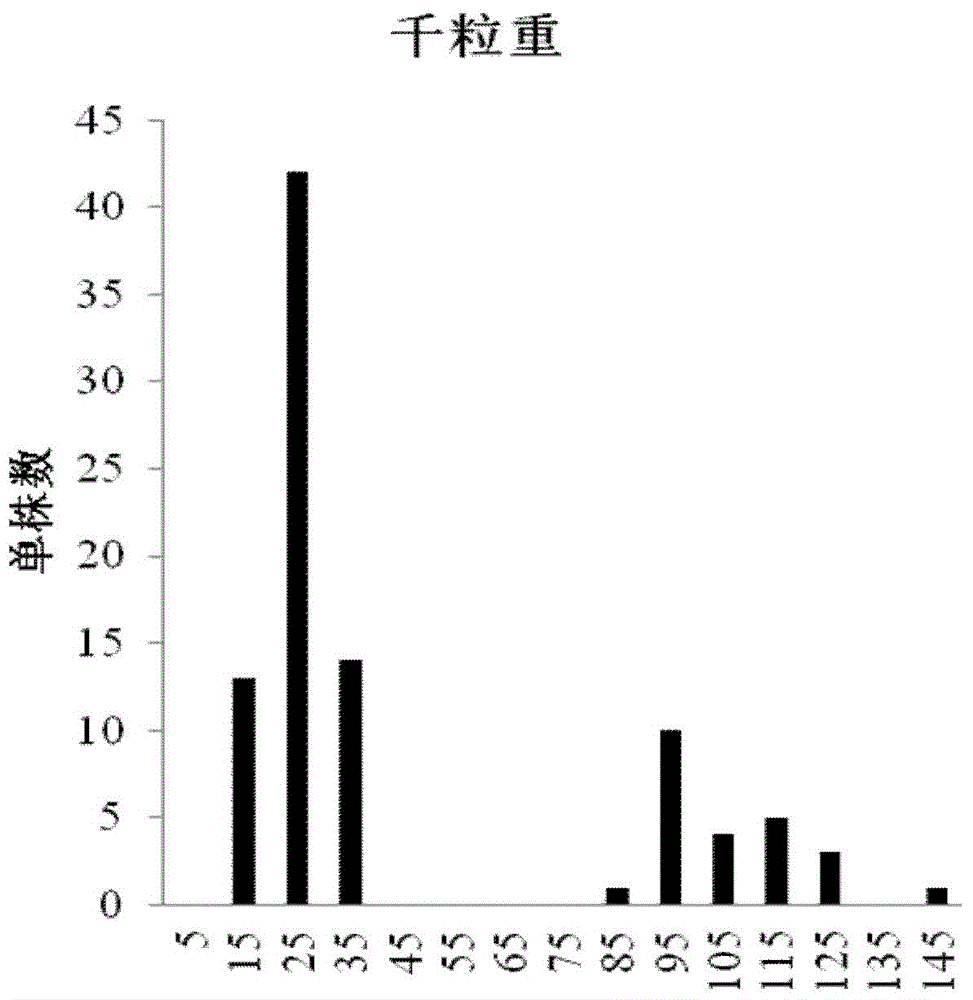InDel molecular marker for identifying watermelon seed size and primers and application thereof
A molecular marker and watermelon seed technology, applied in the field of molecular biology, can solve the problems of SNP marker molecular marker-assisted selection, insufficient stability, cumbersome steps, etc., and achieve the effect of improving selection efficiency and accuracy, stable variation, and low cost
- Summary
- Abstract
- Description
- Claims
- Application Information
AI Technical Summary
Problems solved by technology
Method used
Image
Examples
Embodiment 1
[0037] The development method for identifying the InDel molecular marker of watermelon seed size, the specific steps are as follows:
[0038] (1) Preliminary mapping of genome-wide QTL for thousand-grain weight in watermelon
[0039] F obtained by crossing the female parent "ZXG01478" (large grain) and the male parent "14CB11" (small grain) 2 Populations have constructed high-density genetic linkage maps (see figure 1 ), and for parents, F 1 and F 2 The thousand-grain weight phenotype was identified for 93 individual plants in the population; combined with the genetic linkage map and F 2 Population phenotype identification results ( figure 2 ), using WinQTLcartographer2.5software (http: / / statgen.ncsu.edu / qtlcart / WQTLCart.htm) for initial QTL mapping, a thousand-grain weight major QTL (TSW6) was identified in the LG6 linkage group, and its LOD peak value was 46.94, explaining 26.16% of the phenotypic variation, the confidence interval (2-LOD) is 3.68-31.67cM, and the corr...
Embodiment 2
[0045] Watermelon F 2 and RILs population molecular marker analysis, comprising the following steps:
[0046] (1) Extract the total DNA of leaves by CTAB method, the specific steps are as follows:
[0047] Take 1g of fresh leaves and put them into a mortar, add liquid nitrogen to grind them into powder, then transfer them into a centrifuge tube with 1ml of CTAB extraction solution, mix the two thoroughly, then place them in a constant temperature water bath at 65°C for 60 minutes, and mix them upside down for 2 minutes. ~3 times;
[0048] After taking it out from the water bath, centrifuge at 8000rpm for 1min;
[0049] Take the supernatant and put it in another centrifuge tube, add an equal volume of chloroform: isoamyl alcohol (24:1, V / V), invert gently to mix well;
[0050] Centrifuge at 10000rpm for 5min, and take the supernatant (try not to get the middle sediment);
[0051] Add 0.7 times the volume of isopropanol (need to pre-cool for 30 minutes in advance),...
Embodiment 3
[0092] f 2 The population genetic linkage map was reconstructed, and the steps were as follows: Firstly, the thousand-grain weight morphological marker (TSW6) and other SNP markers on LG6 were used for linkage analysis using Joinmap4.0, and it was found that TSW6 was located in the confidence interval of the main effect QTL TSW6, and was basically at the peak position. Among them, the genetic distance to the nearest marker of TSW6 is 6.8cM ( image 3 B). In addition to the newly developed marker InDel14_S6, re-linkage analysis found that the genetic distance between InDel14_S6 and TSW6 is very close, only 1.0cM ( image 3 C). So far, we have developed a molecular marker InDel14_S6 that is closely linked to the thousand-grain weight QTL (TSW6), which corresponds to a 46 bp indel at 5,478,024 bp on chromosome 6. Its sequence is TAGCAAGAGCGTTACTACTTCAACTAAAAATATCCATTTCATTTTA, and its primer sequence is, InDel14_S6F: TGGTTGTTTCTTTAGGTGGTA; InDel14_S6TTGAR: AGCGAAT The amplified...
PUM
 Login to View More
Login to View More Abstract
Description
Claims
Application Information
 Login to View More
Login to View More - R&D
- Intellectual Property
- Life Sciences
- Materials
- Tech Scout
- Unparalleled Data Quality
- Higher Quality Content
- 60% Fewer Hallucinations
Browse by: Latest US Patents, China's latest patents, Technical Efficacy Thesaurus, Application Domain, Technology Topic, Popular Technical Reports.
© 2025 PatSnap. All rights reserved.Legal|Privacy policy|Modern Slavery Act Transparency Statement|Sitemap|About US| Contact US: help@patsnap.com



